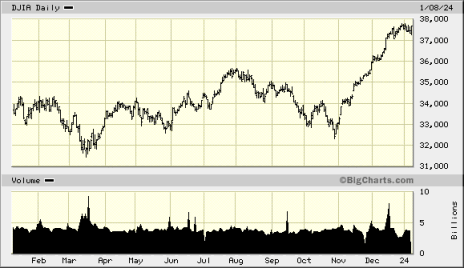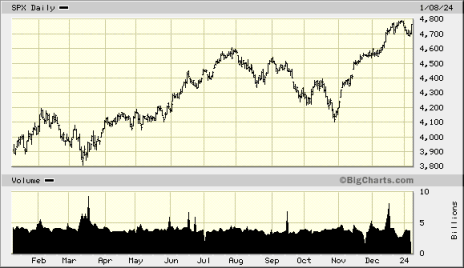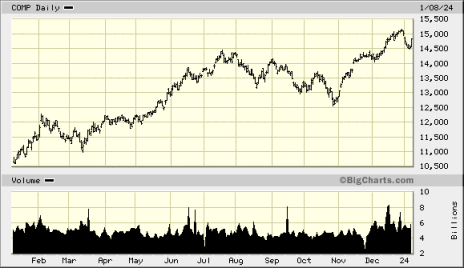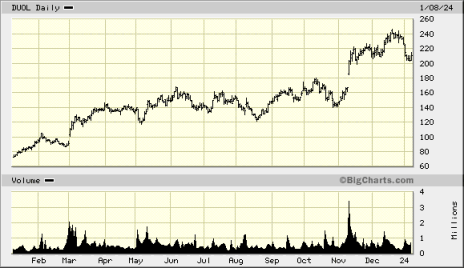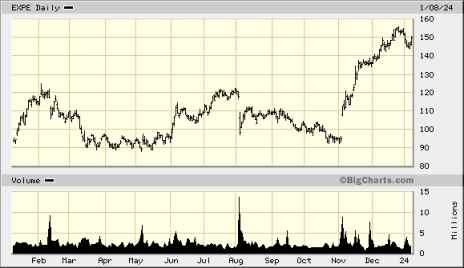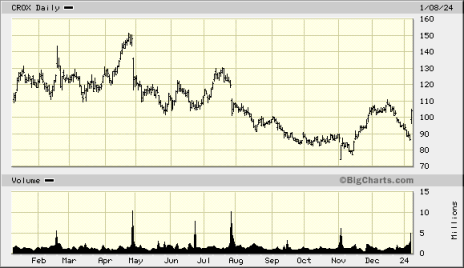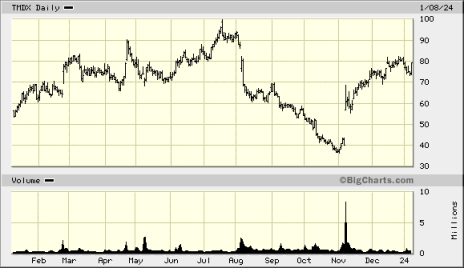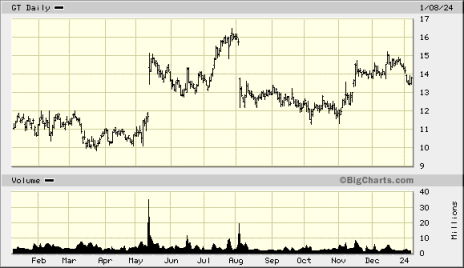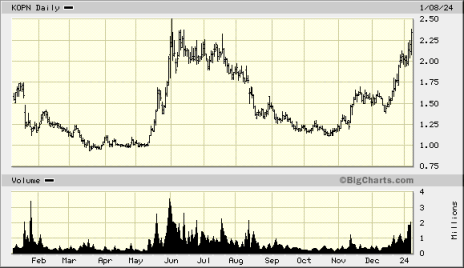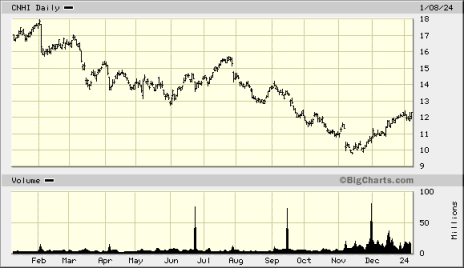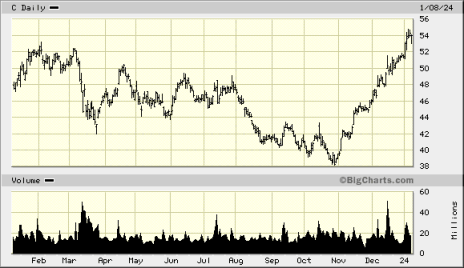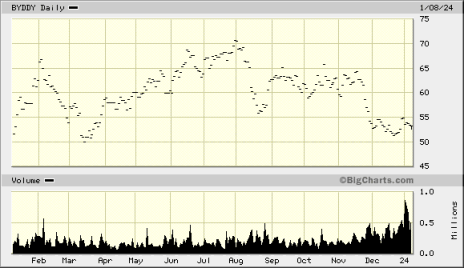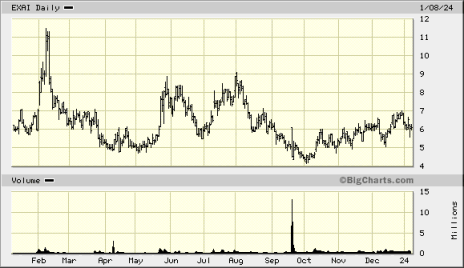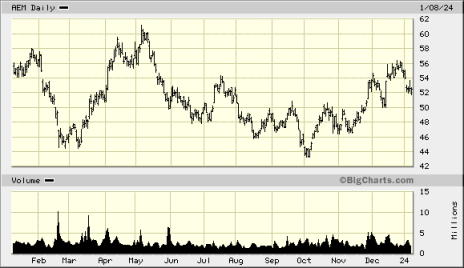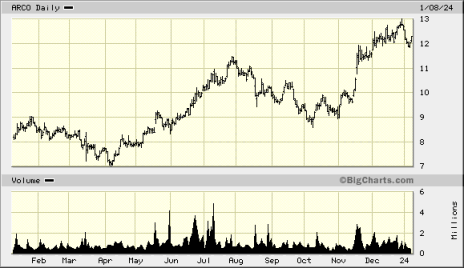Welcome to our TOP PICKS issue! For this issue, I asked the Cabot analysts to give me a couple of their top picks for 2024. And I hope you will be pleased with the diversity—market-cap and sector-wise—that the analysts have offered.
But first, let’s talk about the market.
Market Review
2023 was certainly a sideways year—until November! That’s when the markets took off and gathered most of their gains for the year. In 2023, the Dow Jones Industrial Average gained 16.2%, the S&P 500 rose by 26.3%, and the NASDAQ beat them all, sending the index 44.6% higher.
Growth stocks continued to be the winners for 2023, posting gains of 40.5% for Large Caps, 21.63% for Mid-Caps, and 13.67% for Small Caps. Value stocks—while placing second—still performed okay, with Large Caps up 8.08% and both Mid-Caps and Small Caps rose 8.18%.
Sector-wise, Technology (up 51.94%), Communication Services (up 45.27%), and Consumer Discretionary (up 33.77%) were the leaders. The laggards were Utilities (down 7.28%), Consumer Staples (-2.44%), and Energy (-1.45%).
Looking forward, I think we’ll begin to see some movement in both Value and Small-Cap stocks, due to economic and earnings strength.
The U.S. is still adding jobs, inflation is subsiding, and interest rates look to be on their way down. Those stats should help many industries, but especially housing, which had a so-so year in 2023.
Economists are forecasting mortgage rates to fall into the lower 6% range in 2024, inventory will increase, and existing home sales will rise about 13.5% from last year.
Also, the National Association of Realtors believes new housing starts will rise to 1.48 million in 2024.
The fastest-growing regions of the country will be in the Southern states, with Austin, Texas predicted to be the most attractive real estate market.
All in all, we can’t complain about the 2023 markets, and here at Cabot, 2024 is looking pretty good, too!
Top Picks for 2024
The following two picks are from Mike Cintolo, Chief Analyst of Cabot Growth Investor and Cabot Top Ten Trader:
From Cabot Growth Investor:
Duolingo, Inc. (DUOL) has a great, unique growth story that is only getting bigger, and the consistent string of better-than-expected results has the stock hitting all-time highs.
Duolingo is far and away the top-grossing education app out there, with a fun, game-like system that has goals and rewards along the way. In fact, there are more people learning certain languages on the app than there are native speakers of those languages. The firm also uses a freemium model, with many using the app for free (it has a total of 83.1 million monthly active users, up 47% from a year ago), with ads bringing in some revenue for the firm.
However, the driver is subscriptions, with more and more subscribers choosing to pay up for added features. Paid subscribers (5.8 million total, up 60% from a year ago) are growing nicely, with subscription revenue up 47% from the year before. The firm also does a small business in selling virtual goods on the app, as well as providing an English Learning Test for many institutions and academies.
Growth has been both rapid and consistent, and with so many free users on the platform, converting a few percent of them will keep the arrow pointing up for a long time to come.
That’s the main story. But we think a big part of the excitement last week came from Duolingo’s launch of music and math courses on its app, which obviously opens up entirely new revenue opportunities. To be clear, management doesn’t expect material contributions from those areas for a while as it tests what works, but given the success it’s proven to have in languages, Wall Street is discounting the company succeeding in those (and maybe other) new areas down the road.
As for the stock, it started to really get off its duff in March, but the next few months were very choppy, with three separate 20% corrections. But the Q3 report brought a massive breakout to all-time highs (very impressive, as the stock came public in mid-2021). We think shares can do very well assuming the market shakes off its bearish vibes from the past two years.
From Nancy: Wall Street is pushing this stock higher after the announcement that the company would cut contractors by 10%, as DUOL is depending more on AI to create its content.
With courses in 40 different languages, DUOL has fantastic growth prospects. Analysts are predicting revenues will rise more than 29% and earnings will increase by 100% this year.
From Cabot Top Ten Trader:
Expedia (EXPE): Logic is often overrated in the stock market, which looks ahead and moves up and down—at least as much because of psychology and investor perception as due to cold, hard facts. Expedia is a good example of that. The firm is one of (if not the) largest travel firms, operating many popular sites (including Expedia.com, Hotels.com, VRBO, Orbitz, Travelocity, and many others).
Anyone who’s traveled at all in the past couple of years knows it’s been boom times, with flights and hotels full (and prices up). Indeed, Expedia’s bottom line has recovered in a big way since the pandemic and should notch a new high near $8.50 per share this year, while free cash flow comes in even larger, likely around $15 per share for 2023.
That’s thanks to industry-wide conditions; but also, some company-specific offerings, including a rapidly growing business-to-business platform (revenue up 26% in Q3, making up one-quarter of the total sales) and a unified loyalty offering (dubbed OneKey, where people can earn and spend rewards on/with any of Expedia’s brands).
All brands have now been migrated to a similar-looking app, which means the benefits of a couple of years of hard work should boost things even more going ahead (analysts see earnings up another 26% in 2024 to $10.66 per share).
Despite all that, the stock has been completely waterlogged. It fell more than 60% from peak to trough in 2022, but even as results have cranked ahead, shares were sitting in the low 90s three weeks ago, well within the long bottoming effort it put in for more than a year. But since the Q3 report, the stock is starting to change character. EXPE gapped up 19% on the report and has rallied further since then, challenging resistance in the 120-125 area.
Clearly, this is a turnaround-type situation. Top-line growth is likely to run in the single digits while EBITDA expands in the low/mid-double digits. But our bigger-picture thought is whether EXPE can follow a pattern we’ve seen a lot in recent years: A stock or sector sees earnings explode, often because of some pandemic follow-on effects; though after a run, the sellers arrive as investors expect earnings to fall back to Earth … but instead, earnings keep moving up, eventually leading to another big upleg as investor perception changes.
That seems to be in the cards here, with the cheap valuation, big bottom and now, real accumulation all offering encouragement. The fact that the top brass hasn’t been shy about buying back stock (share count down 8.7% from a year ago; new $5 billion repurchase announced) helps the cause, too. Expedia isn’t going to double in a month, but after a few tough years, we think shares will surprise on the upside in 2024.
From Nancy: For the past two months, analysts have been boosting EXPE’s earnings forecasts, up eight cents to $9.54 per share for 2023. That, as well as the share repurchases Mike mentioned, have given new life to the stock.
Tyler Laundon Chief Analyst, Cabot Small-Cap Confidential and Cabot Early Opportunities offers two picks as well:
Conservative Pick:
Crocs, Inc. (CROX) is a Colorado-based footwear company that was founded in 2002 and has two well-known brands, Crocs and HEYDUDE.
The HEYDUDE brand hasn’t been around as long as the Crocs brand. HEYDUDE was founded in 2008 in Italy and acquired in 2022 by Crocs to the tune of $2.5 billion in cash and stock. Its best-known models are the “Wendy” and “Wally.”
CROX stock fell by more than 50% in the months after the deal was announced. It has since come back, but taking 12 months to get back to “even” after a major acquisition isn’t exactly what CROX shareholders were looking for.
Granted, 2022 was a terrible year for many growth stocks, and not all of it is Crocs’ management’s fault. But some was surely self-inflicted. The stock likely suffered because of a variety of sales, marketing and distribution challenges when the HEYDUDE brand was rolled out. Profit margins took a serious hit as wholesale accounts were flooded with inventory.
There are still some HEYDUDE shoes for sale on Amazon—put there by liquidators—selling for about half of what they sell for on heydude.com. Not great, but also a known issue that management said is in the final innings of being corrected.
That’s (mostly) in the past (hopefully).
Looking forward, it bears noting that Crocs is the fourth-largest footwear brand in North America. While the company has debuted a variety of models over the years, the classic clog still drives around 80% of brand sales, and the Crocs brand drives just over 75% of company sales (i.e., HEYDUDE drives about 25%).
There’s a lot of potential to grow in China (100% growth in Q2 and 90% in Q3) where social media is helping to move the needle. There are also a variety of marketing collaborations putting the brand front and center among various buyer groups. And some of the distributions, warehousing, ERP, etc. issues are being cleaned up.
There is, of course, some risk that operational issues could persist, or that retailers and consumers just won’t gravitate toward the HEYDUDE brand. That’s why this is a potential recovery play.
Looking forward, it’s likely total company revenue growth in 2023 will be about 10% ($3.93 billion) while EPS growth will be about 7% ($11.67).
In 2024, estimates are conservative (remember, recovery story). Analysts are looking for revenue growth of 4.5% ($4.1 billion) and EPS of $12.17 (+4.3%).
In reality, Crocs could do a lot better. If it does the stock could be off to the races.
From Nancy: CROX shares rocketed by 20% in recent days after the company raised its 2023 guidance, saying that revenue will reach $3.95 billion, an increase from its prior forecast of $3.91 billion to $3.94 billion.
Aggressive pick:
TransMedics Group, Inc. (TMDX) is a small-cap MedTech company addressing the unmet market need for more and healthier organs for transplantation, specifically in the heart, lung and liver markets.
It’s not a stock for the faint of heart (no pun intended). But the reward vs. risk profile is, in my view, very attractive.
The company’s revolutionary technology is called the Organ Care System (OCS). OCS replaces a very old standard of care, cold storage, which is too static to meet the dynamic needs of today’s organ transplant market.
The elevator pitch is that the OCS does a better job at preserving organ quality, assessing organ viability prior to transplant, boosting organ utilization and slashing transplant costs.
The OCS is also the foundation of TransMedics’ National OCS Program (NOP), a turnkey solution for transplant centers that provides outsourced organ retrieval and OCS organ management.
The goal of the NOP is to streamline delivery of donor organs from anywhere in the U.S. to a transplant center.
TransMedics is also seeking to streamline the delivery of organs across the country by integrating an aviation business it recently acquired. This means the company would not only have more control over logistics but also be able to capture some of the high fees paid to charter flight operators for organ delivery.
Some of these shorter flights generate $25-$30K in revenue, whereas longer ones could be up to $100K.
Since the aviation business is so new, management hasn’t yet issued guidance on revenue and profit margins. But they have said the focus is on growing revenue and margins in the business and that they’re expanding the fleet and staffing to achieve those goals.
In Q3 2023, aviation added just over $2 million in revenue and the company has nine planes, scaling to 20 by the second half of 2024 (to cover the entire U.S.). That’s just the beginning.
Big picture, there is also potential to expand internationally, especially to Europe, once reimbursement is secured. That’s a longer-term initiative as TransMedics will need to go country by country to get reimbursement. Worth monitoring.
Analysts currently see TransMedics growing 2023 revenue by 145% to around $229 million and delivering an adjusted EPS loss of -$0.93. Looking out into 2024, current consensus points toward revenue growth of 45% ($331 million) and adjusted EPS improvement of 45%, to -$0.51.
If history is any guide, the company will do better. And that will keep TMDX moving higher.
From Nancy: TMDX is also in our Cabot Stock of the Month portfolio and is up more than 12%. Please see my Portfolio Update for further TMDX news.
Here are several Top Picks from Bruce Kaser, Chief Analyst of Cabot Value Investor and Cabot Turnaround Letter:
From Cabot Turnaround Letter:
Our initial thesis for an investment in The Goodyear Tire & Rubber Company (GT) was for an opportunistic purchase of an average company whose shares have fallen sharply out of favor.
Since then, activist investor Elliott Management has taken a 10% stake in the company with the goal of pressing the board to revitalize Goodyear. As a result of the subsequent strategic review, the company will replace its long-running CEO, divest as many as three businesses and streamline its remaining operations to double the profit margin to 10%.
Demand for new and replacement tires should continue to be relatively stable, while pricing will likely remain strong enough to offset rising input costs. Goodyear has excessive debt, but a key priority for the improved free cash flow is to sharply reduce this burden. One intangible is the Goodyear name—one of the world’s most widely recognized and respected consumer brands. All-in, this turnaround offers significant promise for shareholders.
From Nancy: Goodyear is revolutionizing the tire industry with plans to use its smart tires to enable self-driving vehicles. The company just announced an agreement with TDK Corporation (TSE 6762) to develop “next-generation tire solutions with the goal of accelerating the development and adoption of integrated intelligent hardware and software into tires and vehicle ecosystems.”
Kopin Corporation (KOPN) is a small company that is developing high-performance optical display technologies, including headsets and other applications, for military, enterprise, industrial and consumer products.
Since its launch in 1992, the company had been run as a money-losing research hobby of its brilliant founder. The labs generated fascinating prototypes, but these had minimal commercial value, so the company was chronically in need of fresh cash infusions.
Following a pandemic surge due to hype around augmented reality and other potential uses for headsets, Kopin’s shares collapsed over 90%. Recognizing the company’s peril, the founder took the exceptionally rare and equally savvy move of completely stepping away from the company.
This has radically changed Kopin’s trajectory. A new and capable outside CEO, with deep experience in technology and defense companies, is re-orienting the company to become a profitable and growing business. Research efforts are now focused on only the most commercially promising products while savings from eliminating wasteful spending are being redirected toward productive business purposes.
Impressively, the company completed a large and likely final round of raising fresh equity, yielding enough cash to carry the company until it can become free cash flow positive in early 2024. Kopin has zero debt. While the risks are high, so is the potential reward.
From Nancy: Kopin’s new management is already making its mark, procuring more than $26 million in new contracts for weapon sights from a contractor for the Department of Defense.
From Cabot Value Investor:
CNH Industrial N.V. (CNHI) is a major producer of agriculture (80% of sales) and construction (20% of sales) equipment and is the #2 ag equipment producer in North America (behind Deere). Its shares have slid from their peak and now trade essentially unchanged over the past 20 years. While investors see an average cyclical company at the cusp of a downturn, with a complicated history and share structure, we see a high-quality and financially strong company that is improving its business prospects while simplifying itself, yet whose shares are trading at a highly discounted price.
CNH owns high-quality brands that include Case IH and New Holland. The company is highly profitable, with earnings expected to be $2.1 billion next year. Free cash flow for its Industrial operations will be about $1 billion. The Industrial segment balance sheet carries $3.7 billion in cash compared to its $4.6 billion in debt. CNH’s financial segment, whose only business is providing financing for end customers and dealers of its equipment, is conservatively capitalized (9.7% equity ratio) and generates a 12-13% return on equity.
The company’s complicated history includes one-time ownership by Fiat, the Italian manufacturing conglomerate, along with being combined with the Iveco truck, bus and engines business. However, this murkiness is being cleaned up, notably by the separation from Iveco in 2021, leaving only farm and construction equipment along with the in-house financing business.
A legacy of its Fiat days, CNH’s shares currently trade in Milan and New York. This dual-exchange complexity is now being removed. CNH is de-listing its shares from Milan and transitioning all of its share trading to the New York Stock Exchange, effective in early 2024. Near-term, this transition is likely weighing on the share price as Milan traders unwind their positions, so CNH is implementing a $1 billion share buy-back program, with a completion date of March 31, 2024. For perspective, the $1 billion would repurchase about 7% of the company’s shares.
Relatively new CEO Scott Wine, who previously led Polaris (PII) to success, is implementing efficiency programs totaling about $800 million (nearly 4% of revenues) to make CNH more profitable at all points in the cycle. Removing the legacy inefficiencies from its Iveco era is a key component of these programs.
Adding credibility to the company and our thesis is the presence of two major investor-friendly shareholders. The Agnelli family, who controls Fiat, remains a 28% owner and is highly regarded for its investment savvy. Harris Associates, a noted value-focused American investment management firm, holds a 9.3% stake and recently added to its position.
The company’s shares trade at 6.1x per-share earnings. This compares to 12x for Deere and Caterpillar and 7x for Agco. On an EBITDA basis, assuming only book value for the financial segment, CNH’s shares trade at 4.2x EV/EBITDA—also a sizeable discount to its peers. The shares offer an attractive 3.23% dividend yield that looks well-supported by cash flow and the balance sheet. Major investment risks include a possible downcycle, volatile input costs, potential new trade barriers, as well as currency changes and general execution risk.
All-in, the shares look attractive. Investors may want to gradually build their positions – establishing a partial position now and adding on any further weakness, particularly around earnings reports.
From Nancy: Hedge funds are showing interest in CNH, with 29 funds owning shares valued at $590 million, as of the third quarter.
Citigroup Inc. (C) is one of the world’s largest banks, with over $2.4 trillion in assets. Its weak compliance and risk-management culture led to Citi’s disastrous and humiliating experience in the 2009 global financial crisis, which required an enormous government bailout. The successor CEO, Michael Corbat, navigated the bank through the post-crisis period to a position of reasonable stability.
Unfinished, though, is the project to restore Citi to a highly profitable banking company, which is the task of relatively new CEO Jane Fraser. Fraser is narrowing the bank’s geographic focus by exiting 14 international consumer markets, with eight divestitures already completed. Recently, the bank has implemented an aggressive staff reduction and simplification program to help reign in its cost structure. Citi has several valuable businesses, notably its Treasury & Trade Solutions and credit card segments.
Investors have little to no confidence in the bank’s turnaround, so the shares trade at a highly discounted 57% of tangible book value. The sustainable dividend offers investors an attractive 3.9% yield while waiting for the bank’s fundamentals to recover.
From Nancy: Citigroup is also in my Cabot Stock of the Month portfolio and is currently up 23%. Please see my Portfolio Update for more Citi news.
Disclosure Note: The Chief Analyst personally owns shares of all four of these recommended stocks.
Chris Preston, Chief Analyst for Cabot Stock of the Week, recommends BYD Company Limited (BYDDY) as his Top Pick.
Short for “Build Your Dreams,” BYD has quickly become China’s version of Tesla. In March 2022, the company stopped making combustion engine vehicles to go fully electric, or at least mostly electric; it now produces both battery-electric vehicles (BEVs) and hybrids.
The shift in focus paid immediate dividends in a country that loves the electric vehicle: BYD’s revenues leapt to $63.1 billion in 2022 from $33.5 billion in 2021 and $22.7 billion in 2020. This year, BYD has grown revenues by double digits every quarter and is likely to exceed its stated goal of selling more than 3 million electric vehicles.
What makes BYD unique is the wide array of price points on its vehicles. The company just released the “Seagull,” the cheapest electric vehicle in existence at a starting price of a mere $10,200 (or 73,000 yuan). It also makes the most expensive mass-produced car in China, the Yangwang U8, an off-road hybrid that costs $159,000. But neither of those vehicles is BYD’s top seller; those would be the Atto 3/Yuan Plus ($48,500) and the Dolphin ($17,300 - $19,000 range).
BYD’s “something for everybody” identity—with cars for consumers of all income ranges—has Elon Musk spooked. It’s a big reason why Musk and Tesla have repeatedly slashed prices on some of their top models (Model 3 and Y) this year, to better compete with BYD not only in China—where BYD is far and away the largest automaker—but also globally, as BYD is just scratching the surface of its worldwide expansion. It already has a strong foothold in Southeast Asia, where it has shot past Tesla and accounted for more than a quarter of total electric vehicle sales there in the most recent quarter. BYD is also gaining traction in Japan—where the U8 made its Japanese debut at the Japan Mobility Show in October; and Brazil, Israel, New Zealand, Sweden—where the Atto 3 was the top-selling electric vehicle in July—and is expanding into India and other parts of Europe.
Notably, BYD does not yet sell cars in the U.S., and likely won’t for some time in part due to current frigid relations between the U.S. and China. But even without an American presence, BYD sold roughly the same number of BEVs worldwide in the third quarter as Tesla (431,603 to Tesla’s 435,059) and is likely to top Tesla as the global electric vehicle leader as early as the current (fourth) quarter.
And yet … BYD stock has been a bit “meh.” It’s down 25% in the last two years and hasn’t made a major move since rocketing from 11 per share to as high as 68 per share from June 2020 to February 2021. BYDDY shares reached as high as 82 in July 2022 but were promptly sliced nearly in half by year’s end. The stock is up 12% year to date, but its tendency for fits and starts has been maddening, with investors seemingly selling off after every big move, including an 18% faceplant in the second half of November.
All the ups and downs should dissipate once China’s recovery picks up steam, and there are signs that it is after its GDP growth (4.9%) exceeded expectations (4.4%) in the third quarter. U.S. investors will likely be more willing to take on the “risk” of snatching up shares of a Chinese EV stock. And with that stock currently trading at less than 15 times forward earnings estimates—and exactly a third off its 2022 highs—this is an ideal time to buy.
From Nancy: BYD makes its own chips and batteries, giving the company a boost to its gross margins that other EV makers do not have. As Chris noted, BYD is expanding internationally, especially in Asia, and now has a presence in Japan, Thailand, India, Malaysia, Australia, Singapore and more. The company’s vehicles are the number one EV sellers in Israel and BYD is also delivering in Mexico and starting inroads throughout Latin America.
Carl Delfeld, Chief Analyst of Cabot Explorer offers Exscientia plc (EXAI) as his 2024 Top Pick.
Founded in 2012 and based in Oxford, England, Exscientia is using AI to develop new medicines and is attracting high-quality partners.
You have probably heard more than you want about the incredible potential of artificial intelligence (AI). AI enables computers, robots, and other devices to think like humans but far faster and more powerfully. Some refer to AI as “inhuman intelligence” or machine learning.
The potential of AI can be applied to many industries but perhaps the most exciting is the field of medicine. Exscientia has the first AI platform clinically validated to improve treatment outcomes for cancer patients and the world’s first AI-designed drugs to enter clinical trials.
Exscientia has a rapidly growing pipeline of more than 25 projects in motion with the goal of drug discovery in areas such as ovarian, and hematological (blood) cancer.
In total, the company has stated it has eight drugs that are either in trials or likely to be in clinical trials soon. It also has expanding facilities at Oxford Science Park, a new laboratory in Oxfordshire, and medical center in Vienna, Austria.
And they have received grants from the Gates Foundation, as well as equity ownership by that foundation (about 1.3%). Many of Exscientia’s shareholders, in fact, are still the early venture investors from before they went public a little over two years ago (including Softbank, which owns about 5%).
Exscientia stock is trading way off its high in an uptrend at 5.20. It went public at 22 a share so the company has about $500 million in cash on the books—a big number for a company with a market capitalization of just $725 million.
Finally, keep in mind that this is an attractive speculative stock that may have a bumpy ride. It is a young company that is not and will not be profitable next year.
From Nancy: Exscientia was our recommendation in last month’s Cabot Stock of the Month issue. Please see my Portfolio Updates section for more news on the company.
Cabot metals analyst and Top Ten Trader contributor Clif Droke presents Agnico Eagle Mines Limited (AEM) as his Top Pick.
One of the best-quality players in the gold arena is Agnico Eagle Mines, our top pick for 2024 (and our favorite mining stock for leveraging what we view as a gold demand boom in the coming years).
The company is a senior Canadian producer with a pipeline of high-quality exploration and development projects in the U.S., Canada, Mexico and Columbia.
Key to Agnico’s long-term growth plans is the firm’s 100% owned Canadian Malartic mine, which is being transformed from Canada’s second-largest operating gold mine to its largest underground mine, with 15 million ounces of resources being added since 2019.
Another major contributor to Agnico’s expansion efforts is the open-pit Meadowbank complex in Canada, which has seen a 15% year-on-year increase in gold production in the first nine months of this year along with record haulage of underground ore in Q3—plus efforts to extend the mine’s life by several years.
Agnico has described overall production across its mine portfolio as “robust” in recent quarters, with gold production coming in above the mid-point of annual guidance and cost performance remaining “solid.”
Payable gold production in the latest quarter was over 850,000 ounces at production costs per ounce of $893 and with all-in sustaining costs (a key metric) of $1,210 per ounce—well under the current gold price of ~$2,100 and leaving Agnico in a strong position to benefit from additional gold price increases.
The firm will enter the new year in a flexible financial position with $355 million in cash and over $1 billion in available liquidity, which should help Agnico’s expansion plans going forward along with dividend payments (a 3.1% yield).
Wall Street sees earnings growth of 11% next year, which is likely to prove too conservative given the likelihood of higher gold prices.
From Nancy: The company will release earnings on February 15. Analysts are forecasting $0.43 on $1.67 billion in revenues and have increased their estimates in the past 60 days.
My 2024 Top Pick is Arcos Dorados Holdings Inc. (ARCO). ARCO is the largest independent McDonald’s franchisee in the world and the largest quick-service restaurant chain in Latin America and the Caribbean. The company has the exclusive right to own, operate, and grant franchises of McDonald’s restaurants in 20 countries and territories in Latin America and the Caribbean, including Argentina, Aruba, Brazil, Chile, Colombia, Costa Rica, Curacao, Ecuador, French Guiana, Guadeloupe, Martinique, Mexico, Panama, Peru, Puerto Rico, Trinidad and Tobago, Uruguay, the U.S. Virgin Islands of St. Croix and St. Thomas, and Venezuela.
Latin America has a growing middle class which is leading to higher incomes and better access to credit. In this expanding environment, ARCO and its sub-franchisees own and operate 2,300 Latin American McDonald’s restaurants, employing more than 95,000 people.
Arco handily beat analysts’ earnings estimates in its third quarter, reporting EPS of 30 cents, considerably more than the consensus estimate of 20 cents, as well as 2022’s third-quarter earnings of 23 cents per share. ARCO’s revenues rose 21.7%, year over year, to $1,115 million, also walloping Wall Street’s forecasts of $1,076 million.
Analysts expect ARCO to see EPS growth around 18.8% this year, higher than the industry average of 17.9%. And I won’t be surprised if that number expands, as consensus estimates have been rising for the past few months, more than 9% in just the last 30 days.
Trading-wise, Arcos Dorados boasts a PEG ratio of 1.17 compared with 2.23 for the industry. And its P/E ratio is just 14.19.
The shares are ranked “Strong Buy” by the analysts covering the company. Just 41.81% of its shares are owned by institutional investors, which means any big purchases could further boost the company’s share price.
ARCO has a market cap of $2.57 billion, and only 130.66 million shares outstanding. I consider the shares a bargain at this price.
Portfolio Updates
Tom Hutchinson, Chief Analyst of Cabot Dividend Investor updated his outlook on Qualcomm Inc. (QCOM), saying, “Although QCOM was a technology laggard in 2023 with a 34% total return, it has been coming alive lately. It soared about 40% higher between late October and the end of the year. I believe this is a company that will benefit from the AI revolution later than the 2023 movers and shakers. But it will come to mobile devices. Qualcomm is introducing new AI chips for PCs and smartphones that could be big sellers next year. It’s looking like 2024 could be a much better year. QCOM has already started to ascend but it remains a long way from the all-time high. BUY.”
Wall Street is positive on Qualcomm, which has a current analyst rating of 1.75, on a scale of 1 to 5 (Strong Buy to Strong Sell).
The company recently announced its new Snapdragon XR2+ chip designed for virtual and mixed-reality headsets. It can run 12 or more high-definition cameras and will compete with Apple Inc.’s forthcoming Vision Pro. The component will be used by Samsung Electronics Co. and Alphabet Inc.’s Google on products those companies currently have under development.
Continue to Buy.
In his update on Citigroup (C), Bruce Kaser, Chief Analyst of Cabot Value Investor and Cabot Turnaround Letter reported that “Citigroup shares rose 2% in the past two weeks and have 63% upside to our 85 price target. Since reaching lows in late October, Citi shares have surged 35%, highlighting the merits of holding onto stocks, and possibly adding to positions, on weakness rather than selling along with everyone else. The shares remain attractive as they trade at about 60% of tangible book value of $86.90. The dividend offers investors a 3.8% yield. BUY.”
The bank’s Chief Financial Officer, Mark Mason, recently said “he expects Citigroup to complete its reorganization by the end of the first quarter.”
The stock’s recent moves up are a boon to Citi’s investors and a complete turnaround should offer even further appreciation. Continue to Buy.
Michael Brush, Chief Analyst of Cabot Cannabis Investor, made some 2024 predictions for the cannabis industry, which should help boost the price of Curaleaf’s (CURLF) shares. He noted that “The U.S. will move cannabis to Schedule III from Schedule I under the Controlled Substances Act. The change puts a strong bid under cannabis stocks because of the positive implications for companies in the space. While falling short of technically legalizing cannabis at the federal level, the change increases cash flow dramatically by wiping out the impact of an Internal Revenue Service (IRS) rule that bars companies from deducting most expenses. Known as Rule 280E, the provision means cannabis companies pay around a 70% tax rate.”
He also predicted that “The federal government will get around to putting excise taxes on cannabis, which vary depending on potency as with alcohol. But the net change still boosts cash flow dramatically at cannabis companies. The next step in this process, called ‘rescheduling,’ is Drug Enforcement Agency publication of a proposed rule. This could happen as soon as April. ‘April 20 is a good date to do it,’ quips Curaleaf board chair Boris Jordan. That’s a reference to ‘420’ which is slang for cannabis, but he is serious about the possible April timeline for this catalyst. BUY.”
Continue to Hold.
Tyler Laundon, Chief Analyst for Cabot Early Opportunities and Cabot Small-Cap Confidential, still finds TransMedics Group (TMDX) attractive. He remarked that “We’re still awaiting confirmation that the aviation business is ramping up and that this significant investment will ultimately pan out and help management achieve its vision of turning TransMedics into the go-to service provider for lung, liver and heart transplants in the U.S., (and eventually select international markets). HOLD A QUARTER.”
Wall Street has become more bullish toward the shares, citing its 26% third-quarter revenue rise and forecasting a smaller loss than expected a few months ago.
I agree with Tyler. Continue to Hold.
The recommendation of Brookfield Infrastructure Partners (BIP) was updated by Tom Hutchinson, who commented, “It was a subpar year in 2023 for BIP. A return of just 6.55% for the year badly lagged all the market indexes as interest rate sensitive stocks were under pressure most of the year. But interest rates have likely peaked and are moving lower and BIP has come alive again. It’s up a whopping 47% since late October. BIP had been a safe superstar dividend performer until 2022. Now the high distribution and highly reliable infrastructure earnings are catching on again. It looks like the storm for BIP is over and 2024 should be a great year. (This security generates a K1 form at tax time). BUY.”
Analysts expect the company’s recent acquisitions will also boost its growth, and predict a double-digit rise in FFO to come.
Continue to Buy.
Bruce Kaser also updated his take on NOV, Inc (NOV), saying, “NOV shares rose 1% in the past two weeks and have 22% upside to our 25 price target. The dividend produces a reasonable 1.0% dividend yield. BUY.”
NOV will report fourth-quarter and full-year 2023 results on Friday, February 2, 2024. Wall Street expects the company to post EPS of $0.42 on $2.26B in revenues.
Continue to Buy.
Carl Delfeld, Chief Analyst of Cabot Explorer, reports that “International Business Machines (IBM) shares were firm this week as Big Blue continues its transformation centered on cloud computing, data security, analytics, and AI. The company has $11 billion worth of cash and generated $10.3 billion of free cash flow over the last four quarters. Those funds are aimed at the AI opportunity right now. The stock also has upside potential as it only gained 16% in 2023, falling behind the S&P 500’s 25% increase. BUY a Half.”
Although investors may still think IBM is not as exciting as some of the newer AI companies, we must remember that the company has been working on AI long before most of these newer businesses were even founded! And don’t forget about the dividend, a healthy yield of 4.17%.
I agree with Carl. Buy.
Gates Industrial Corp, plc (GTES) hasn’t had much news lately, but Bruce Kaser noted that “Gates shares rose 8% in the past two weeks and have 17% upside to our 16 price target. BUY.”
The shares have seen some nice momentum lately. Continue to Buy.
Tom Hutchinson noted that “UnitedHealth Group Inc. (UNH) has a spectacular long-term track record but has struggled somewhat with just a 1% return in 2023. Most healthcare stocks have struggled in the 2023 market for a host of reasons. But those reasons are unlikely to persist going forward. This stock has a stellar track record and can perform well in a slowing economy. UNH could make up for lost time as different stocks continue to come back into favor. BUY.”
Analysts expect UNH’s service expansions and a stronger market will help boost the shares this year, following a double-digit earnings increase.
Continue to Buy.
Carl Delfeld also updated our newest recommendation (also a Top Pick for 2024), noting, “Exscientia (EXAI) shares tumbled from 6.6 to 6 this past week as the company announced that Sanofi is adding a new discovery stage program identified and advanced by Exscientia into their current collaboration. Exscientia has ongoing agreements to co-develop drugs with Bristol-Myers Squibb and Sanofi. This is an aggressive idea in a promising field. BUY a Half.”
Continue to Buy.
Portfolio
| Company | Symbol | Date Bought | Price Bought | Price on 1/10/24 | Gain/ Loss % | Rating | Risk Tolerance |
| M | |||||||
| M | |||||||
| A | |||||||
| A | |||||||
| EXAI | A | ||||||
| GTES | M | ||||||
| M | |||||||
| IONQ | 9/15/23 | A | |||||
| NE | 8/11/23 | M | |||||
| NOV | 6/8/23 | M | |||||
| QCOM | 7/15/22 | M | |||||
| TMDX | |||||||
*Aggressive (A), Moderate (M), Conservative (C)
ETF Strategies
Our ETF portfolio took advantage of the recent market rally with all but four positions in the black. Gaining double digits are Communication Services Select Sector SPDR Fund (XLC, up 29.79%), iShares US Energy (IYE, up 21.54%), First Trust Water ETF (FIW, up 20.58%), and ALPS Medical Breakthroughs ETF (SBIO, up 17.09%).
This month, I’m taking O’s Russell Smallcap Qlty Divd ETF (OUSM) off of our Watch List and adding it to our portfolio.
5 Star
Low Risk
Small Cap Blend/Value
Dividend Yield: 1.64%
Under normal market conditions, the fund will invest at least 80% of its total assets in the components of the index. The index is designed to reflect the performance of publicly listed small-capitalization dividend-paying issuers in the United States that meet certain market capitalization, liquidity, high quality, low volatility and dividend yield thresholds, as determined by O’Shares Investment Advisers, LLC.
| Total Return % | 2017 | 2018 | 2019 | 2020 | 2021 | 2022 | 2023 | YTD |
| Investment (Price) | 10.81 | -10.61 | 28.03 | 7.65 | 21.44 | -7.89 | 18.82 | -0.84 |
| Investment (NAV) | 10.70 | -10.30 | 27.63 | 7.58 | 21.56 | -7.89 | 18.82 | -0.85 |
Top 10 Holdings (20.80% of Total Assets) | ||
| Name | Symbol | % Assets |
| Williams-Sonoma Inc | WSM | 2.49% |
| MarketAxess Holdings Inc | MKTX | 2.35% |
| Teleflex Inc | TFX | 2.20% |
| Lincoln Electric Holdings Inc | LECO | 2.17% |
| Chemed Corp | CHE | 2.13% |
| Tradeweb Markets Inc | TW | 1.94% |
| New York Times Co Class A | NYT | 1.90% |
| Owens-Corning Inc | OC | 1.89% |
| Juniper Networks Inc | JNPR | 1.88% |
| Old Republic International Corp | ORI | 1.84% |
Our Watch List has two names remaining:
- GX U.S. Infrastructure Development ETF (PAVE)
- Vanguard Small Cap Growth Index Fund (VBK)
Portfolio
| Company | Symbol | Risk Tolerance* | Recommendation | Date Bought | Price Bought | Price on 1/10/24 | Gain/ Loss % |
*Aggressive (A), Moderate (M), Conservative (C)
**Purchase price reflects a 3-for-1 stock split
The next Cabot Money Club Stock of the Month issue will be
published on February 8, 2024.

